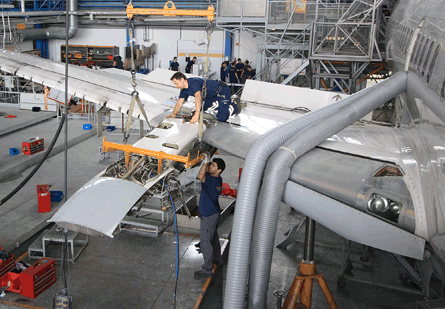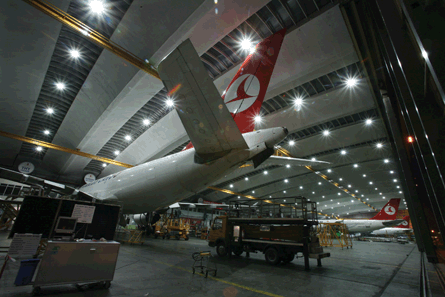While long-haul aircraft lend themselves to undergoing airframe heavy maintenance in far-flung locations with low labour rates, there remains strong competition among European maintenance, repair and overhaul (MRO) providers to service the extensive narrowbody fleets of local carriers - particularly along the fringes of the old continent.
The base maintenance business is changing, however, and low man-hour rates are not the only factor determining where the labour-intensive, low-yield work will be done.
Global MRO provider Lufthansa Technik (LHT) opened a four-bay hangar for single-aisle aircraft in Budapest a decade ago.
While the Hungarian site still offers cost advantages over Western European locations, this benefit has reduced and - more significantly - new and yet cheaper MRO providers have sprung up further afield.
 |
|---|
© Lufthansa TechnikLufthansa Technik Budapest has been operation for 10 years |
"Prices and yields are constantly under strong pressure, so we have to become continuously better to ensure our survival," LHT Budapest chief executive Elmar Lutter says.
In other words, low labour costs may have been part of the starting capital in the facility's early days, but its lasting existence will depend on making a constant effort to create value for the customer.
SHIFTING SCHEDULES
Further complications arise as maintenance events are becoming more individualised and, arguably, less predictable.
Classic overhaul events, where the aircraft is in the hangar for typically four weeks, are becoming rare, as operators try to phase traditional D-check tasks over multiple C-checks on modern aircraft.
These usually take eight to 10 days for a narrowbody, and involve less labour and material than a full overhaul.
For MRO providers which have grown under the old system, and built up large teams of structural technicians, this development can be a bugbear - especially if present growth rates are insufficient to allocate the staff across more customers and aircraft.
On the other hand, structural repairs on aging airframes can turn out to be more extensive than initially anticipated.
For example, wing corrosion has become a typical issue on older Airbus A320-family aircraft. Findings can easily jeopardise the downtime for a regular C-check, as the intensive repair requires zero-stress jacking with several jacks per wing.
| |
|---|
© Turkish TechnicIs a gentleman's agreement required? Turkish Technic has raised the possibility |
However, while the aircraft occupies the hangar bay longer than potentially planned, the repair work requires only a small team.
Juggling facility capacity and striking the right balance between team size and skills are thus becoming more important.
As more modern aircraft enter into service, there is a long-term shift among the workforce from traditional airframe maintenance jobs - such as structural technicians and painting staff - to more licensed mechanics and avionics experts, says Lutter.
A similar point is made by Jean-Marc Lenz, vice-president aircraft services and VIP at Zurich, Switzerland-based SR Technics. "The dissolution of classic base maintenance schedules is a clear trend," he says, adding that SR Technics has thus far had "very positive experiences" with its "E-check" concept, which it developed for EasyJet.
Nevertheless, the Mubadala subsidiary and sister company of Abu Dhabi Aircraft Technologies (ADAT) has halted a planned expansion of its dedicated narrowbody airframe overhaul centre in Malta for the time being, because it was unable to attract customers in addition to the UK budget carrier.
Its Malta operation was launched from a leased two-bay hangar in October 2010, and the intention was to build a four-bay facility by early 2012, but this was put on ice in January.
SR Technics says that it will continue training local staff in Malta, and that it cooperates with the island's government and local partners "to win new customers and grow the business".
OEM MARKET GRIP
While shifting base maintenance schedules and the continuous pressure to become ever more cost-efficient are signs of a natural evolution of the MRO industry, third-party maintenance providers must face a far more fundamental challenge - the growing aftermarket influence of the original equipment manufacturers (OEMs).
Access to construction and maintenance documentation has become increasingly restricted, as manufacturers began to embrace the aftermarket as part of their products' revenue stream.
While the capital requirements to develop new repair capabilities have always been a hurdle for MRO providers, this filter was later complemented by the continuous slimming down of maintenance manuals and other support forms, such as uncomplicated spare-parts supply to independent overhaul shops.
Parallel to this development, the OEMs have built up their own service infrastructures - be it through their own facilities or in partnership with selected MRO providers.
New technologies have acted as a further catalyst. Most recently, the move from traditionally separate onboard systems towards software-controlled components on the Airbus A380 and Boeing 787, whereby the equipment is linked up to work as an integrated server network, has contributed to further OEM control.
 |
|---|
© Turkish Technic |
While the novel systems architecture offers enormous flexibility in terms of functionality, it will be difficult for MRO providers to understand the equipment to a similar depth as had been the case with previous system generations, says Dirk Winkler, senior sales executive at Lufthansa Technik. "Like on a computer at home, one becomes merely [a] user, without a detailed understanding what is going at the back," he added.
This is echoed by the chief executive of Vilnius-based maintenance company FL Technics, Jonas Butautis. He says: "New aircraft will be like flying sets of software. [Manufacturers] control the software and core [processors]. So for me it is logical to become part of the OEM system for the aftermarket."
Airline-affiliated MRO providers, such as LHT or Air France Industries KLM Engineering & Maintenance, have traditionally had negotiating leverage against the OEMs through the buying power of their parent carriers.
This is waning, however, as new airlines - which have no maintenance operations of their own - make large fleet orders with long-term OEM maintenance agreements.
A recent example was AirAsia, which ordered 200 A320neos with a 20-year full-support engine contract with engine MRO provider CFM International.
"Where is the role of the [third-party] MRO within this arrangement?" asks Butautis. "This is going to be the interesting question for all the MROs to find their niche in this world."
He sees no alternative but to co-operate with the OEMs in the future. However, he also thinks that manufacturers need the experience of local MRO companies to offer operators appropriate support, as maintenance services vary across the world.
GENTLEMEN'S AGREEMENT
Turkish Technic chief executive Ismail Demir wonders whether a "gentlemen's agreement" between manufacturers and maintenance providers will be necessary to ensure the survival of MRO providers, with at least some degree of independence in the long-term.
While he does not expect the manufacturers to make their intellectual property freely available to service their equipment, it should be accessible at a "reasonable price", he says.
Another prerequisite would be that aviation authorities maintain sufficient regulatory room and support for third-party MRO companies and suppliers to develop alternative repairs and spare parts.
This would be carried out independently from OEMs under the respective designated engineering representative, design organisational approval and parts manufacturer approval rules.
As engine and component MROs have been areas where manufacturers and maintenance providers have competed - and in many cases also co-operated - for some time, it has lately been the turn of the airframers to target the aftermarket as well.
With Airbus and Boeing selecting individual MRO companies as authorised service centres for their respective Flight Hour Service (FHS) and GoldCare programmes, the obvious question is whether it will be possible for a partner in one of the schemes to maintain the models of the other manufacturer.
"It is expected that airframers will force the MROs to align with one of them," Demir says. "If you align with one of them, they will not let you play [with the other]."
However, he does see some leeway. He says that if Turkish Technic was, for example, an Airbus FHS partner, but its parent airline was interested in buying 787s - with the premise that the aircraft will be supported in-house - it would be difficult for Boeing to refuse such an arrangement.
To what extent the MRO company would then be able to offer its 787 maintenance capabilities to third-party customers is another matter, however.
Without the ability to market the new skills, it would be questionable to invest in the respective training and equipment in the first place.
The relationship between MRO provider and manufacturer, be it as partners or competitors, will depend on the former's technical expertise and market standing, according to Demir.
He thinks the more engineering capabilities the maintenance company develops - and the more value-added services it can thus offer to its customers - the stronger it will be against the OEMs.
If that is true, a partnership with a manufacturer could be a lifeline for MRO providers with less resources.
Source: Flight International
























